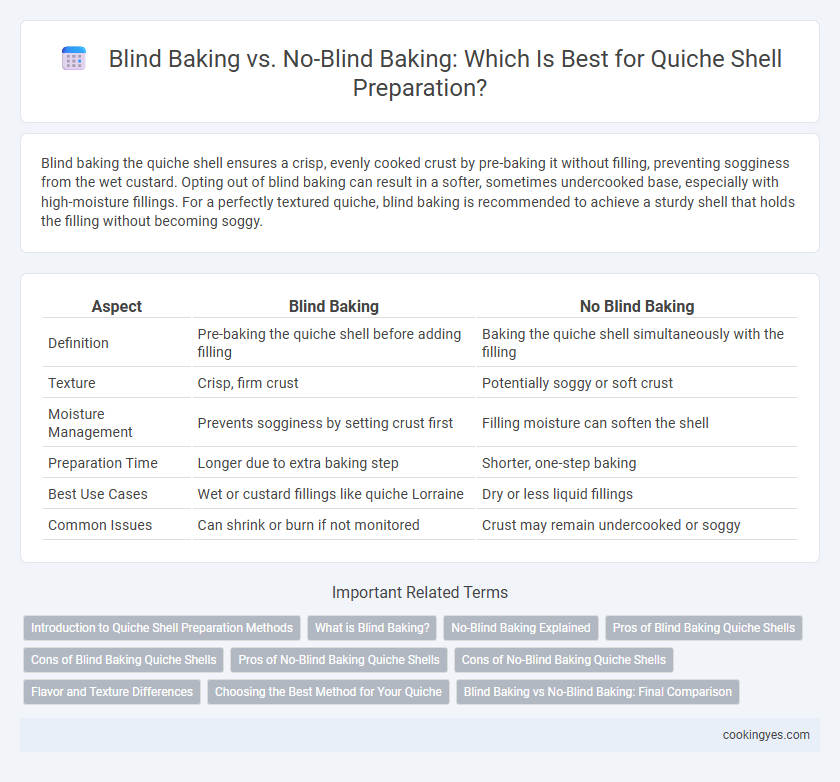Blind baking the quiche shell ensures a crisp, evenly cooked crust by pre-baking it without filling, preventing sogginess from the wet custard. Opting out of blind baking can result in a softer, sometimes undercooked base, especially with high-moisture fillings. For a perfectly textured quiche, blind baking is recommended to achieve a sturdy shell that holds the filling without becoming soggy.
Table of Comparison
| Aspect | Blind Baking | No Blind Baking |
|---|---|---|
| Definition | Pre-baking the quiche shell before adding filling | Baking the quiche shell simultaneously with the filling |
| Texture | Crisp, firm crust | Potentially soggy or soft crust |
| Moisture Management | Prevents sogginess by setting crust first | Filling moisture can soften the shell |
| Preparation Time | Longer due to extra baking step | Shorter, one-step baking |
| Best Use Cases | Wet or custard fillings like quiche Lorraine | Dry or less liquid fillings |
| Common Issues | Can shrink or burn if not monitored | Crust may remain undercooked or soggy |
Introduction to Quiche Shell Preparation Methods
Blind baking a quiche shell involves pre-baking the crust to prevent sogginess, ensuring a crisp texture that holds up against moist fillings like custard and vegetables. No-blind baking skips this step, allowing for a softer, more tender crust that absorbs some filling moisture, often preferred for simpler or less watery ingredients. Choosing between blind baking and no-blind baking depends on the desired crust texture and the moisture content of the quiche filling.
What is Blind Baking?
Blind baking is the process of pre-baking a quiche shell before adding the filling to prevent a soggy crust and ensure a crisp texture. It involves lining the dough with parchment paper or foil and filling it with pie weights or dried beans to maintain its shape during baking. This technique is especially important for custard-based quiches where the filling is liquid and requires a fully baked crust.
No-Blind Baking Explained
No-blind baking involves preparing the quiche shell without pre-baking, which allows the crust to absorb moisture from the filling and results in a softer texture. This method works best with custard-based fillings that cook thoroughly in the oven, preventing the crust from becoming soggy. Skipping blind baking saves time and simplifies preparation while maintaining a tender, flaky crust that complements creamy quiche fillings.
Pros of Blind Baking Quiche Shells
Blind baking quiche shells prevents a soggy bottom by pre-cooking the crust before adding the filling, ensuring a crisp and firm texture. It helps maintain the shape of the shell, especially when using wet fillings like custard or vegetables, by preventing shrinkage and bubbling. This technique results in a more evenly cooked crust, enhancing the overall quality and presentation of the quiche.
Cons of Blind Baking Quiche Shells
Blind baking quiche shells often results in overcooked or excessively dry crusts due to extended exposure to high oven temperatures without filling protection. This method may cause uneven browning and shrinkage, compromising the shell's texture and structural integrity. Additionally, blind baking increases preparation time and requires extra tools like pie weights, which can be inconvenient for home cooks.
Pros of No-Blind Baking Quiche Shells
No-blind baking quiche shells retain a tender, flaky texture by avoiding over-drying that can occur during blind baking. This method simplifies preparation by allowing the crust to bake simultaneously with the filling, saving time and reducing the risk of burning the crust. Moisture from the filling helps keep the shell soft and less prone to cracking compared to blind-baked crusts.
Cons of No-Blind Baking Quiche Shells
No-blind baking quiche shells often result in a soggy bottom due to moisture release from the filling, compromising texture and structural integrity. Without pre-baking, the crust may fail to fully cook, leading to an underbaked, doughy consistency that detracts from flavor and mouthfeel. Furthermore, insufficient heat exposure can cause the dough to shrink or puff unevenly, affecting the quiche's overall presentation and quality.
Flavor and Texture Differences
Blind baking a quiche shell enhances texture by creating a crisp, golden crust that prevents sogginess from the custard filling. Without blind baking, the crust often remains softer and can absorb moisture, resulting in a slightly doughy texture with less distinct layers. Flavor profiles differ as blind baking develops a toasted, nutty note in the crust, while skipping this step yields a milder, less complex base.
Choosing the Best Method for Your Quiche
Blind baking a quiche shell prevents sogginess by pre-cooking the crust, ensuring a crisp, sturdy base that holds the custard filling without becoming waterlogged. No-blind baking allows the dough to cook simultaneously with the filling, which can result in a softer crust but saves preparation time and simplifies the process. Choosing the best method depends on the desired texture and filling moisture; for high-moisture quiches, blind baking yields optimal results, while no-blind baking suits drier fillings or quicker recipes.
Blind Baking vs No-Blind Baking: Final Comparison
Blind baking a quiche shell ensures a crisp, fully cooked crust by pre-baking the dough before adding the filling, preventing sogginess from moist ingredients. No-blind baking involves filling the unbaked crust directly, which can result in a softer, sometimes undercooked bottom due to steam and moisture from the filling. The final choice depends on desired texture: blind baking guarantees firmness and structure, while skipping it may offer a more tender, though potentially less stable, crust.
Blind baking vs No-blind baking for quiche shell preparation Infographic

 cookingyes.com
cookingyes.com